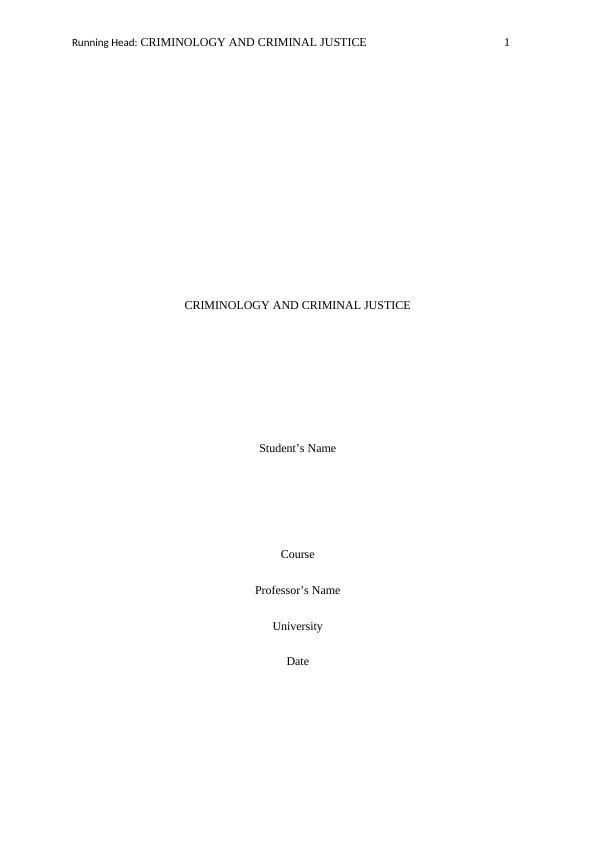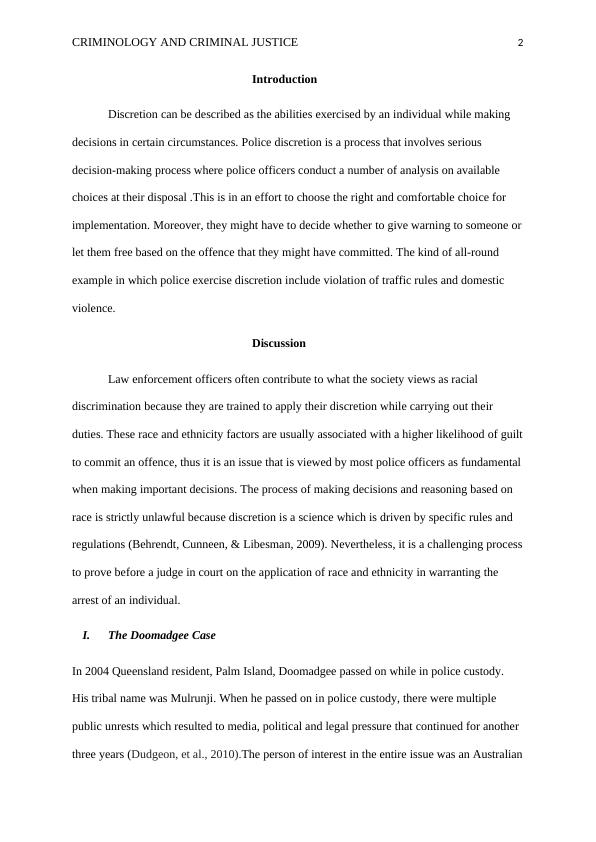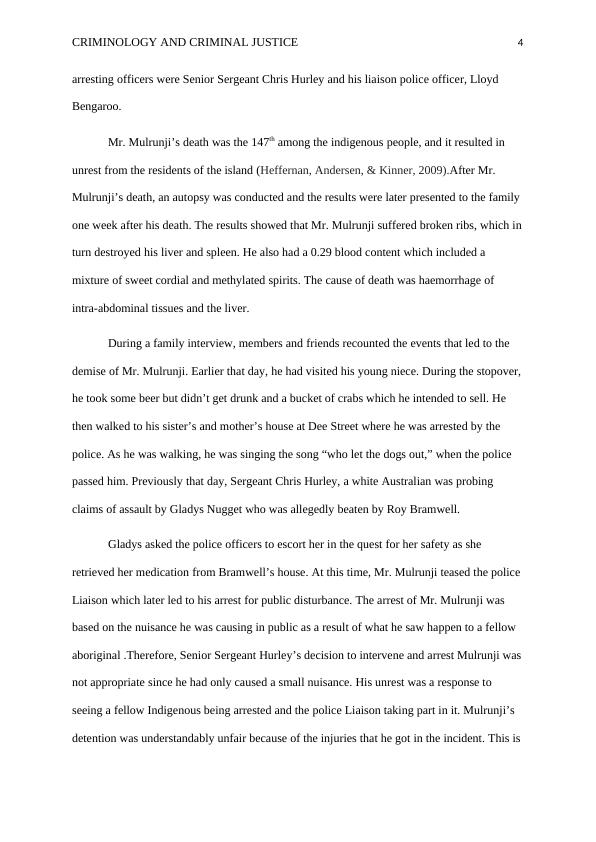Police Discretion and Racial Discrimination in Criminology and Criminal Justice
Added on 2023-04-07
12 Pages2977 Words314 Views
Running Head: CRIMINOLOGY AND CRIMINAL JUSTICE 1
CRIMINOLOGY AND CRIMINAL JUSTICE
Student’s Name
Course
Professor’s Name
University
Date
CRIMINOLOGY AND CRIMINAL JUSTICE
Student’s Name
Course
Professor’s Name
University
Date

CRIMINOLOGY AND CRIMINAL JUSTICE 2
Introduction
Discretion can be described as the abilities exercised by an individual while making
decisions in certain circumstances. Police discretion is a process that involves serious
decision-making process where police officers conduct a number of analysis on available
choices at their disposal .This is in an effort to choose the right and comfortable choice for
implementation. Moreover, they might have to decide whether to give warning to someone or
let them free based on the offence that they might have committed. The kind of all-round
example in which police exercise discretion include violation of traffic rules and domestic
violence.
Discussion
Law enforcement officers often contribute to what the society views as racial
discrimination because they are trained to apply their discretion while carrying out their
duties. These race and ethnicity factors are usually associated with a higher likelihood of guilt
to commit an offence, thus it is an issue that is viewed by most police officers as fundamental
when making important decisions. The process of making decisions and reasoning based on
race is strictly unlawful because discretion is a science which is driven by specific rules and
regulations (Behrendt, Cunneen, & Libesman, 2009). Nevertheless, it is a challenging process
to prove before a judge in court on the application of race and ethnicity in warranting the
arrest of an individual.
I. The Doomadgee Case
In 2004 Queensland resident, Palm Island, Doomadgee passed on while in police custody.
His tribal name was Mulrunji. When he passed on in police custody, there were multiple
public unrests which resulted to media, political and legal pressure that continued for another
three years (Dudgeon, et al., 2010).The person of interest in the entire issue was an Australian
Introduction
Discretion can be described as the abilities exercised by an individual while making
decisions in certain circumstances. Police discretion is a process that involves serious
decision-making process where police officers conduct a number of analysis on available
choices at their disposal .This is in an effort to choose the right and comfortable choice for
implementation. Moreover, they might have to decide whether to give warning to someone or
let them free based on the offence that they might have committed. The kind of all-round
example in which police exercise discretion include violation of traffic rules and domestic
violence.
Discussion
Law enforcement officers often contribute to what the society views as racial
discrimination because they are trained to apply their discretion while carrying out their
duties. These race and ethnicity factors are usually associated with a higher likelihood of guilt
to commit an offence, thus it is an issue that is viewed by most police officers as fundamental
when making important decisions. The process of making decisions and reasoning based on
race is strictly unlawful because discretion is a science which is driven by specific rules and
regulations (Behrendt, Cunneen, & Libesman, 2009). Nevertheless, it is a challenging process
to prove before a judge in court on the application of race and ethnicity in warranting the
arrest of an individual.
I. The Doomadgee Case
In 2004 Queensland resident, Palm Island, Doomadgee passed on while in police custody.
His tribal name was Mulrunji. When he passed on in police custody, there were multiple
public unrests which resulted to media, political and legal pressure that continued for another
three years (Dudgeon, et al., 2010).The person of interest in the entire issue was an Australian

CRIMINOLOGY AND CRIMINAL JUSTICE 3
police officer. He was taken for a court trial for the first time since the establishing of the
office of public prosecution. After a series of hearing the person of interest was acquitted of
all the charges against him by a jury in 2007 after the accusation of Mulrunji’s death in
custody (Dale, & Krawitz, 2011).The major legal questions that came up from Mulrunji’s
death was: Was Mulrunji’s taking into custody lawful? Did he die due to injuries inflicted on
him by the police officer?
The officer who arrested him was solely responsible for the injuries inflicted on
Mulrunji. Ideally, Mulrunji’s demise raised further political questions concerning the Royal
Commission of 1990. The main objective of establishing the commission was to prevent
more deaths of Indigenous people while in custody. It was questionable whether the
committee proposals had been effected by the government or they were disregarded
altogether (Cunningham, & Paradies, 2013).
II. The association Between Police and Indigenous People
The Indigenous communities of Australia are made of people who have gone through
multiple racial discrimination .The foundation of such discriminative perceptions is the idea
that “superior” communities view them as communities of low state (Prenzler, 2009). As a
result, recent studies have confirmed that the Indigenous communities have been targeted by
police discretion irrespective of the type and magnitude of offence hey have committed.
Therefore, regardless of the Suggestions given by the Royal Commission of 1990, new rules
of accountability by law enforcement officer have not been enforced.
Mulrunji was an aboriginal Australian who was 36 years old at the time of his demise.
His death followed an hour after he was detained and charged with instigating public
disturbance .The suspect was locked up in the back side of Palm Island Police station. The
police officer. He was taken for a court trial for the first time since the establishing of the
office of public prosecution. After a series of hearing the person of interest was acquitted of
all the charges against him by a jury in 2007 after the accusation of Mulrunji’s death in
custody (Dale, & Krawitz, 2011).The major legal questions that came up from Mulrunji’s
death was: Was Mulrunji’s taking into custody lawful? Did he die due to injuries inflicted on
him by the police officer?
The officer who arrested him was solely responsible for the injuries inflicted on
Mulrunji. Ideally, Mulrunji’s demise raised further political questions concerning the Royal
Commission of 1990. The main objective of establishing the commission was to prevent
more deaths of Indigenous people while in custody. It was questionable whether the
committee proposals had been effected by the government or they were disregarded
altogether (Cunningham, & Paradies, 2013).
II. The association Between Police and Indigenous People
The Indigenous communities of Australia are made of people who have gone through
multiple racial discrimination .The foundation of such discriminative perceptions is the idea
that “superior” communities view them as communities of low state (Prenzler, 2009). As a
result, recent studies have confirmed that the Indigenous communities have been targeted by
police discretion irrespective of the type and magnitude of offence hey have committed.
Therefore, regardless of the Suggestions given by the Royal Commission of 1990, new rules
of accountability by law enforcement officer have not been enforced.
Mulrunji was an aboriginal Australian who was 36 years old at the time of his demise.
His death followed an hour after he was detained and charged with instigating public
disturbance .The suspect was locked up in the back side of Palm Island Police station. The

CRIMINOLOGY AND CRIMINAL JUSTICE 4
arresting officers were Senior Sergeant Chris Hurley and his liaison police officer, Lloyd
Bengaroo.
Mr. Mulrunji’s death was the 147th among the indigenous people, and it resulted in
unrest from the residents of the island (Heffernan, Andersen, & Kinner, 2009).After Mr.
Mulrunji’s death, an autopsy was conducted and the results were later presented to the family
one week after his death. The results showed that Mr. Mulrunji suffered broken ribs, which in
turn destroyed his liver and spleen. He also had a 0.29 blood content which included a
mixture of sweet cordial and methylated spirits. The cause of death was haemorrhage of
intra-abdominal tissues and the liver.
During a family interview, members and friends recounted the events that led to the
demise of Mr. Mulrunji. Earlier that day, he had visited his young niece. During the stopover,
he took some beer but didn’t get drunk and a bucket of crabs which he intended to sell. He
then walked to his sister’s and mother’s house at Dee Street where he was arrested by the
police. As he was walking, he was singing the song “who let the dogs out,” when the police
passed him. Previously that day, Sergeant Chris Hurley, a white Australian was probing
claims of assault by Gladys Nugget who was allegedly beaten by Roy Bramwell.
Gladys asked the police officers to escort her in the quest for her safety as she
retrieved her medication from Bramwell’s house. At this time, Mr. Mulrunji teased the police
Liaison which later led to his arrest for public disturbance. The arrest of Mr. Mulrunji was
based on the nuisance he was causing in public as a result of what he saw happen to a fellow
aboriginal .Therefore, Senior Sergeant Hurley’s decision to intervene and arrest Mulrunji was
not appropriate since he had only caused a small nuisance. His unrest was a response to
seeing a fellow Indigenous being arrested and the police Liaison taking part in it. Mulrunji’s
detention was understandably unfair because of the injuries that he got in the incident. This is
arresting officers were Senior Sergeant Chris Hurley and his liaison police officer, Lloyd
Bengaroo.
Mr. Mulrunji’s death was the 147th among the indigenous people, and it resulted in
unrest from the residents of the island (Heffernan, Andersen, & Kinner, 2009).After Mr.
Mulrunji’s death, an autopsy was conducted and the results were later presented to the family
one week after his death. The results showed that Mr. Mulrunji suffered broken ribs, which in
turn destroyed his liver and spleen. He also had a 0.29 blood content which included a
mixture of sweet cordial and methylated spirits. The cause of death was haemorrhage of
intra-abdominal tissues and the liver.
During a family interview, members and friends recounted the events that led to the
demise of Mr. Mulrunji. Earlier that day, he had visited his young niece. During the stopover,
he took some beer but didn’t get drunk and a bucket of crabs which he intended to sell. He
then walked to his sister’s and mother’s house at Dee Street where he was arrested by the
police. As he was walking, he was singing the song “who let the dogs out,” when the police
passed him. Previously that day, Sergeant Chris Hurley, a white Australian was probing
claims of assault by Gladys Nugget who was allegedly beaten by Roy Bramwell.
Gladys asked the police officers to escort her in the quest for her safety as she
retrieved her medication from Bramwell’s house. At this time, Mr. Mulrunji teased the police
Liaison which later led to his arrest for public disturbance. The arrest of Mr. Mulrunji was
based on the nuisance he was causing in public as a result of what he saw happen to a fellow
aboriginal .Therefore, Senior Sergeant Hurley’s decision to intervene and arrest Mulrunji was
not appropriate since he had only caused a small nuisance. His unrest was a response to
seeing a fellow Indigenous being arrested and the police Liaison taking part in it. Mulrunji’s
detention was understandably unfair because of the injuries that he got in the incident. This is

End of preview
Want to access all the pages? Upload your documents or become a member.
Related Documents
Police Discretion and Criminal Justicelg...
|13
|3587
|51
Berghuis v. Thompkins: Miranda Rights and Waiverlg...
|17
|5089
|52
Undocumented Immigrant as a Witness: A Case Brief on the Challenges Faced by David Camposlg...
|4
|640
|490
